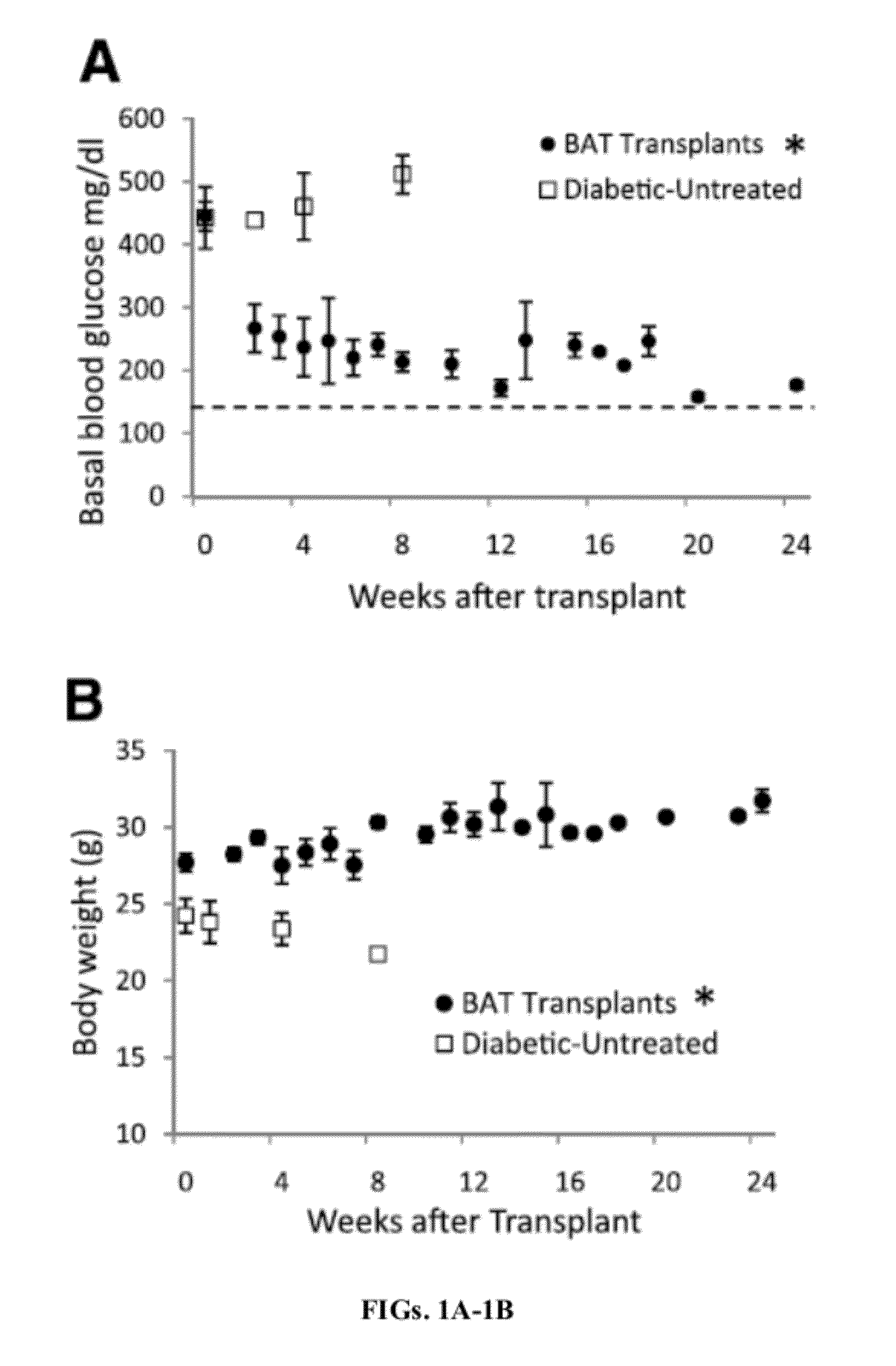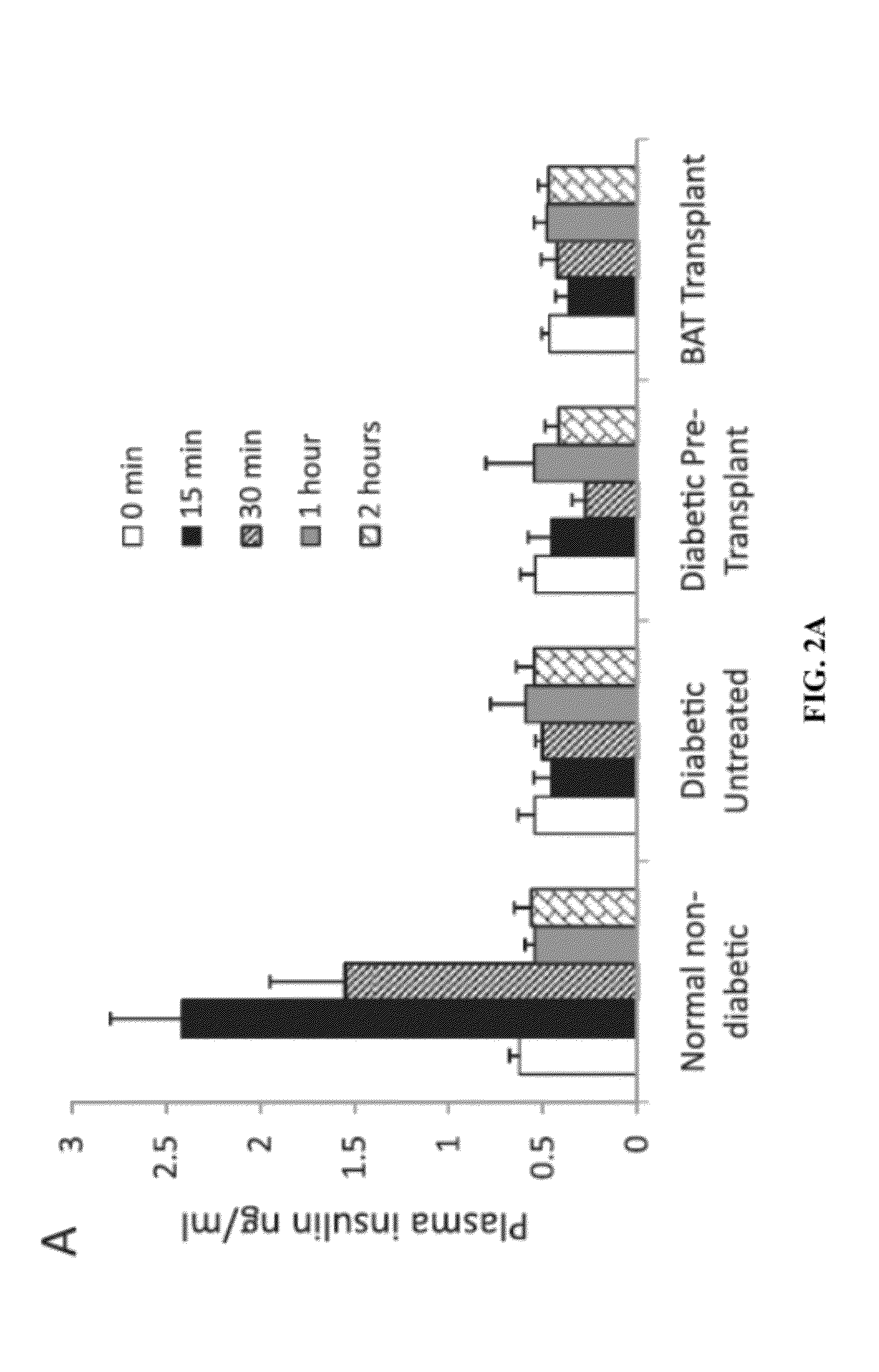Methods For Treating Type Diabetes With Brown Adipose Transplants
a transplantation method and brown adipose technology, applied in the field of human cell biology and pathology, can solve the problems of not taking any preventive or curative measure that can be taken against type 1 diabetes, unable to reverse or prevent type 1 diabetes, and unable to lose weight quickly and dangerously, so as to achieve the effect of restoring normoglycemia, suppressing, attenuating or inhibiting hyperglucogonemia
- Summary
- Abstract
- Description
- Claims
- Application Information
AI Technical Summary
Benefits of technology
Problems solved by technology
Method used
Image
Examples
example 1
Materials & Methods
[0183]Research Design and Methods.
[0184]Embryonic BAT was transplanted in the subcutaneous space of STZ-diabetic recipients. Recipient mice included C57BL / 6J mice, and NCRNU-M-M nude mice. Donor adipose tissue came from E16-E17 C57BL / 6J embryos. Weight was recorded and basal fed blood samples were collected at regular intervals from mice that received BAT transplants as well as normal non-diabetic control mice and untreated diabetic control mice. Intra-peritoneal glucose tolerance tests were performed before BAT transplants and at monthly intervals after BAT transplants. Metabolic parameters such as blood glucose; insulin response to glucose and arginine; and plasma levels of adiponectin, leptin, glucagon and IGF-1 were measured from transplant and control groups at regular intervals. Three months after BAT transplant, mice were subjected to an additional glucose tolerance test in the presence of 5961, an inhibitor of insulin receptor. One insulin tolerance test w...
example 2
Results
[0199]BAT Transplants Promote Weight Gain and Euglycemia.
[0200]STZ-treated diabetic C57BL / 6J mice receiving embryonic BAT transplants show marked improvement of glucose homeostasis (FIGS. 1A-D). Successful BAT transplants are defined as those diabetic mice whose basal blood glucose levels decreased by at least 200 mg / dl within 8 weeks of receiving a BAT transplant. FIGS. 1A-5B show the major results for immune-competent C57BL / 6J mice, while the parallel findings in immune-deficient NCRNU nude mice (as well as additional data for C57BL / 6J mice) are shown in the supplemental figures. Nine out of 14 transplants were successful (FIG. 1A), resulting in euglycemia and reversal of clinical signs of diabetes. These mice exhibit gradual weight gain, as opposed to the weight loss seen in the untreated diabetic control groups (FIG. 1B). This weight gain is partially attributable to the replenishment and expansion of subcutaneous white adipose tissue. Animals in the BAT transplant group ...
example 3
Discussion
[0212]Here, the inventors have shown that regeneration of healthy adipose tissue can reverse clinical diabetes and re-establish glucose homeostasis with no detectable contribution from insulin (FIGS. 1-2). The correction of diabetes phenotypes by brown adipose tissue transplants in STZ-treated mice can persist for over six months, without immunosuppression or hormone supplements (FIG. 1). These data suggest that these BAT transplants achieve chronic regulation of glucose through a steady-state elevation of alternative hormones, such as adiponectin, leptin and IGF-1 (FIG. 4). This regulation correlates with the maintenance of healthy and non-inflamed adipose tissue, as demonstrated by the inflammatory changes in adipose tissue associated with the diabetic state (FIG. 3). Although insulin is not required, activation of the insulin receptor still appears to play a physiological role since its blockade leads to impaired glucose tolerance in the transplant recipients (FIG. 5).
[...
PUM
 Login to View More
Login to View More Abstract
Description
Claims
Application Information
 Login to View More
Login to View More - R&D
- Intellectual Property
- Life Sciences
- Materials
- Tech Scout
- Unparalleled Data Quality
- Higher Quality Content
- 60% Fewer Hallucinations
Browse by: Latest US Patents, China's latest patents, Technical Efficacy Thesaurus, Application Domain, Technology Topic, Popular Technical Reports.
© 2025 PatSnap. All rights reserved.Legal|Privacy policy|Modern Slavery Act Transparency Statement|Sitemap|About US| Contact US: help@patsnap.com



